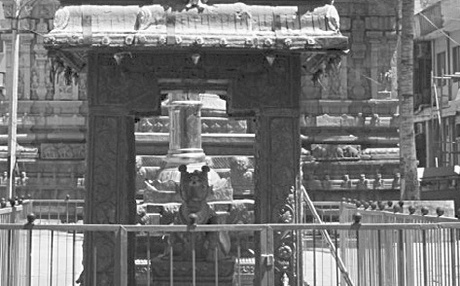Someshwara temple is particularly known for its magnificent architecture and its intricately carved pillars that produce music.
An amazing thing happened recently in the busy neighbourhood of Ulsoor. Researchers found a Kalyani (open pond) almost adjacent to the Someshwara temple, one of Bangalore oldest temples, buried under a craggy piece of land that housed a milk dairy and some houses. The ten-day excavation work uncovered a 1,200-year-old stepped open pond.
One of the unique features of this temple is that although Someshwara (Shiva or Eshwara) is the presiding deity, Vishnu, Brahma, Kamakshamma, Arunachaleswara, Bhimeswara, Nanjundeswara and Panchalingeswara are also worshipped here.
The beauty of Someshwara temple even attracted the prime minister of Canada, Stephen Harper and his wife, Laureen Harper to visit it. The temple is particularly known for its magnificent architecture and its intricately carved pillars that produce music. The five-tier Mahadwara Mantapa, elaborate with statues of gods and goddesses, and another well executed gopuram on the east entrance, are typical 16th century structures.
An exquisite pillar, Nandi Kambha, stands in front of a small but beautiful gopura in the open courtyard. There is a spacious open mantapa consisting of four large projecting ‘bays’ (area between four pillars) which leads to a closed mantapa whose walls are decorated with pilasters and sculptures.
A narrow passage connects the closed mantapa to the Garbagriha or the Sanctum. The open mantapa is covered with standard Yali (mythical beast) pillars. In all, there are 48 pillars with beautiful carvings of gods and goddesses that are said to produce the sounds of musical instruments when tapped.
To the north is the Navagraha temple, which has carved pillars depicting the 12 rashis. Two dwarapalakas (guards) watch over the main entrance to the garbagriha (sanctum sanctorum).
The temple also houses beautiful sculptures which narrate the story of King Ravana of Lanka lifting Mount Kailasha, Goddess Durga slaying Mahishasura and idols of the Shaivaite saints.
There are carving of Girija Kalyana (the holy wedding of Lord Shiva and Parvathi) on the outer wall of the sanctum sanctorum.
Lord Brahma, Lord Vishnu, the seven rishis, the twelve adityas and eleven rudras are also a part of the wedding procession, with King Himalaya performing the kanyadana.
A Sri chakra is found inside the Kamakshi sannidhi which is a rare, as they are usually found only in Shakthi Kshetras.
Another attraction of the temple is the Ashwattha Katte, a huge old banyan tree whose age is not known.
History of the temple: While the temple’s actual history is unknown, Benjamin Lewis Rice in the ‘Gazetter of Mysore’ (1887), describes a legend behind the construction of the temple.
King Kempe Gowda had a strange dream while on a hunt in which Lord Someshwara instructed him to build a temple in his honour using buried treasure.
According to a different version, it was King Jayappa Gowda (1420-1450 CE), uncle of Kempe Gowda, from a minor dynasty called “Yelahanka Nada Prabhu” built the temple. He employed a sculptor from Belur, a descendant of the famous Janakachari to construct the temple.
Another account attributes the temple to the Cholas Dynasty in the 10th century and renovated by rulers of Yelahanka.
Legend has it that the linga in the sanctum was the one that was being worshipped by sage Mandavya.
S K Aruni, historian of Indian Council for Historical Research, classifies the construction to three different periods – the Cholan period (inner most sanctum sanctorum, inner hall and its enclosing wall), the Vijayanagar period (outer pillared hall and mukhamantapa) and early colonial period (Kamakshi Amman temple, the nandimantapa and balipeeta).
The medieval historians say that Lord Cornwallis first camped here while mulling over methods to overpower Tipu Sultan.
It is also said that Abbakka Rani used to worship here five centuries ago.
Abbakka Rani was a 16th century princess who hated the Portuguese and even divorced her husband for accepting their impositions. She fought her husband and eventually gave up her life rather than surrender to the Portuguese.
The excavation of the Kalyani is still underway and the area is fenced to avoid people from crowding there. Even old-timers like Yuvaraj, who stays right next to the site, didn’t know about the pond till excavation started.
There are no records but legend has it that this pond was closed down by the British almost 150 years ago as the tank had dried up. However Laxminarayana Dixit, the 90-year-old Chief Priest of the temple, refutes these claims. “No one knows who or why this pond was closed,” he states.
The excavation struck water at 20 feet. “We don’t know how deep it is or its physical dimensions. We are eagerly awaiting the findings of the dig based on the survey conducted by the BBMP, Muzrai department and Archeological Survey of India,” explained Govindaraju, President, Sri Someshwara Swamy Temple Development Committee.
Whatever be the physical dimensions of the Kalyani, one thing is sure, once it is restored to its past glory, the beauty of the temple will increase manifold.
source: http://www.newindianexpress.com / Home> Cities> Bangalore / by Dr. Mamatha B R – Bangalore / March 28th, 2013
